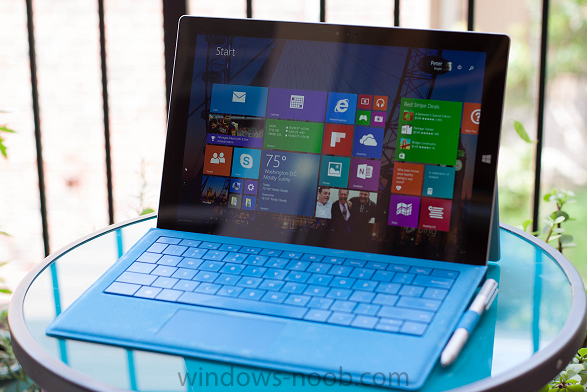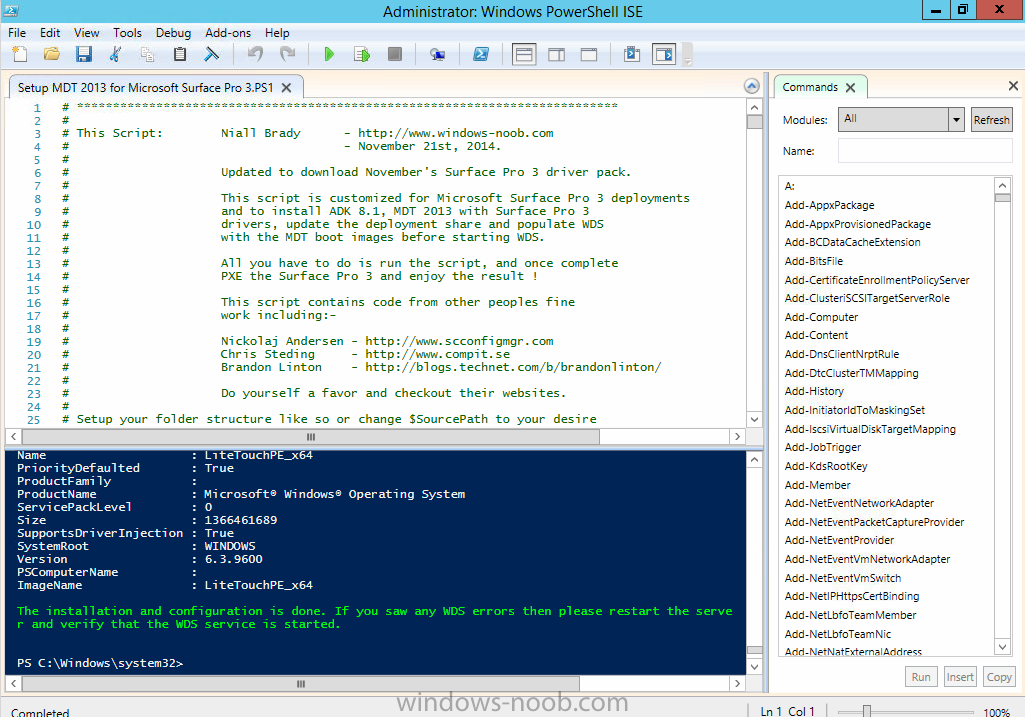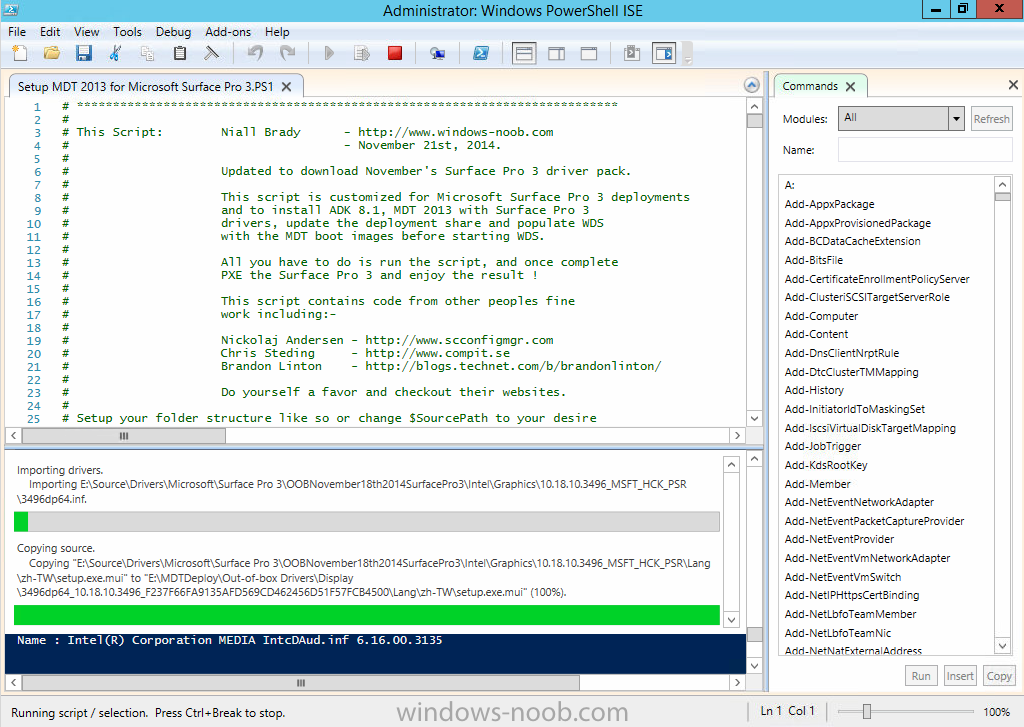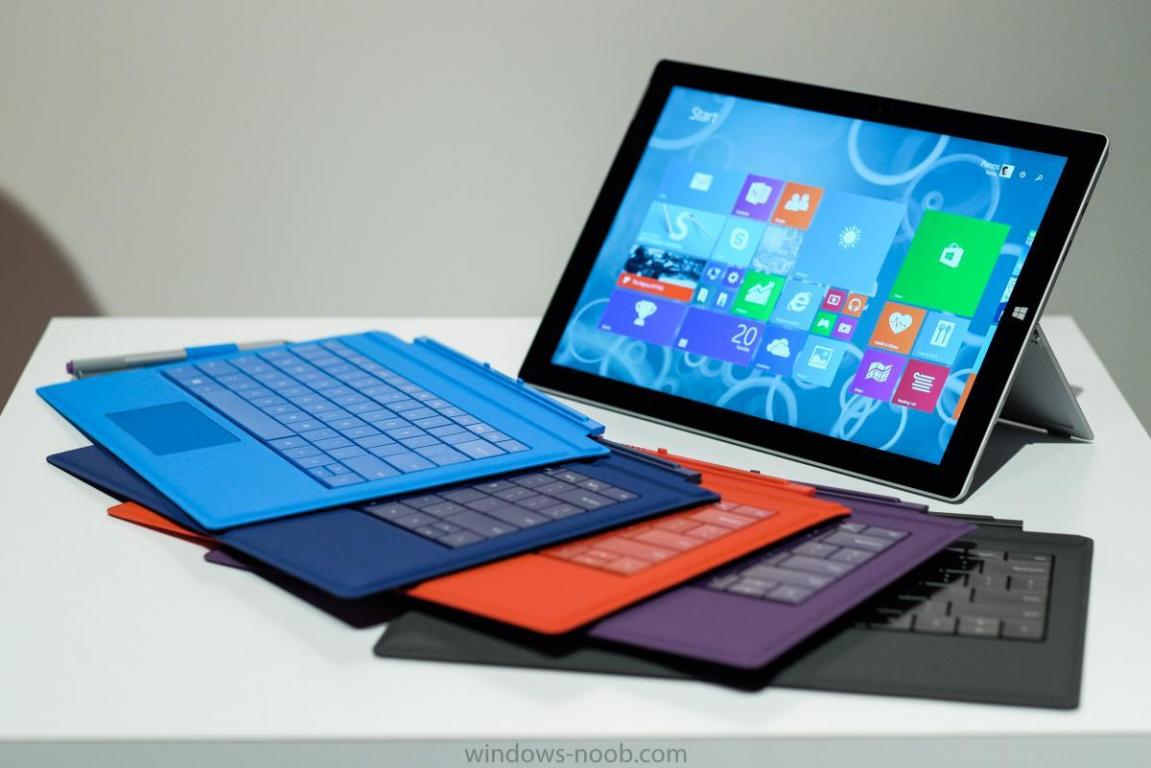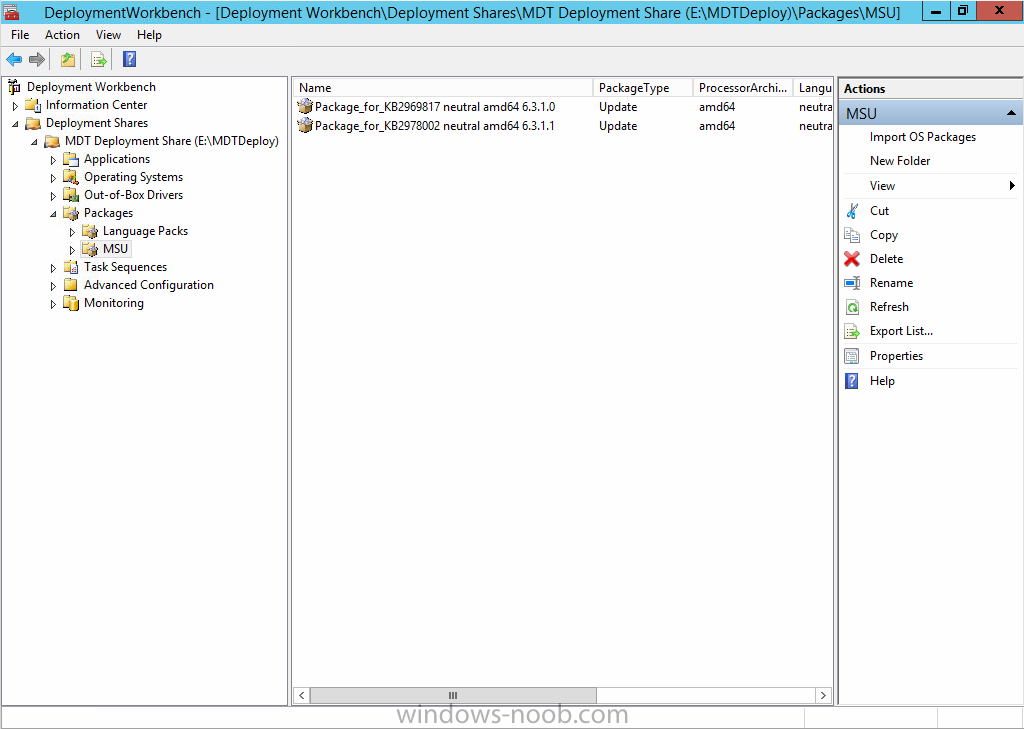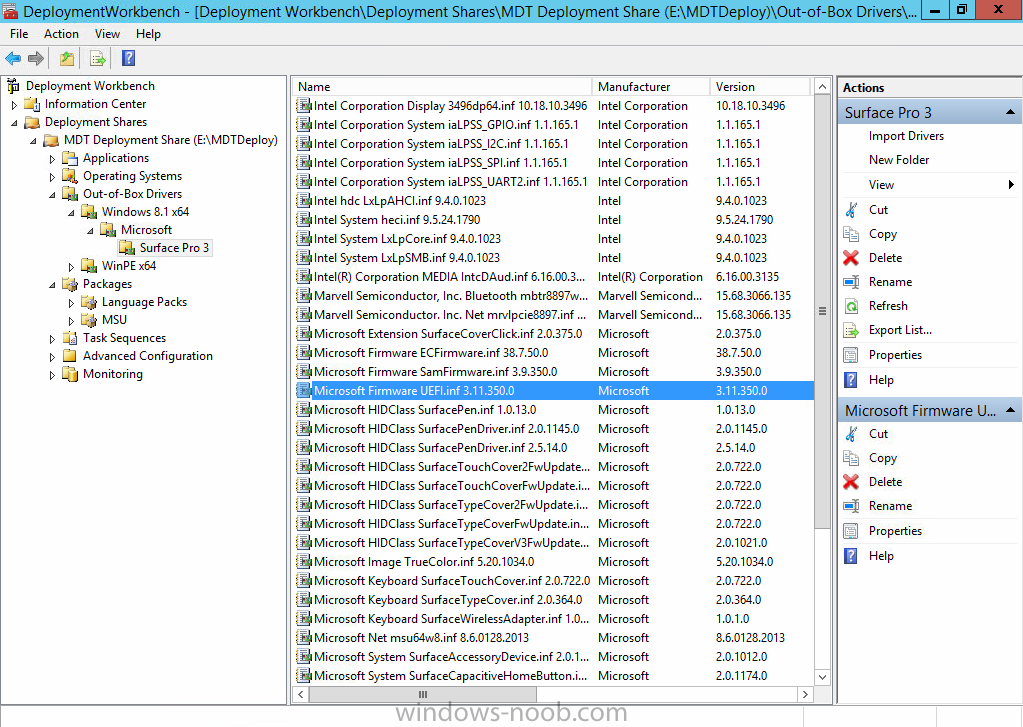-
Posts
9247 -
Joined
-
Last visited
-
Days Won
369
Everything posted by anyweb
-

SCCM PXE client rebooting after preparing network connections
anyweb replied to chrischambers's question in How do I ?
and you shouldn't be adding wireless or bluetooth drivers to your boot wim, only import the network driver you actually need for the deployment. -
I recently recorded 5 videos in Seattle with Simon May at the Microsoft recording studios on the subject of deploying the Microsoft Surface Pro 3 using Configuration Manager 2012 R2 and MDT 2013 and going into details about UEFI hardware and how to deal with all the problems it brings about. The entire course is on Microsoft Virtual Academy here, and the recordings are available on Channel 9, you can see the content listed below. Please do check them out ! 45 minutes, 4 seconds (Module 1) Deployment Basics Surface Pro 3 Deployment Nov 22, 2014 at 7:01 AM In Deployment Basics we cover why Virtualization is key when doing OSD, we look at different Deployment Methods and also how to Capture your reference image. We explain the differences between UEFI versus Legacy and then look at why Automation is important and how to automate using PowerShell. Then… 51 minutes, 42 seconds (Module 2) Deploying Surface Pro 3 with Configuration Manager Surface Pro 3 Deployment Nov 22, 2014 at 7:02 AM In this module you learn which is the correct version of Configuration Manager. You are shown where to download the correct drivers and which ones you need, and you learn how to Import those drivers into Configuration Manager. Next you'll learn about distributing the Surface Pro 3 Driver Package and how to add the network drivers to the X64 boot wim. After that you'll create and edit a Windows 8.1 task sequence before Deploying it. You learn why LIFO and boot images are important and you'll learn about importing Surface Pro 3 hardware into Configuration Manager and finally, you'll look at creating USB Media … 40 minutes, 37 seconds (Module 3) Deploying Surface Pro 3 with MDT Surface Pro 3 Deployment Nov 22, 2014 at 7:03 AM In this module you'll learn Why to use MDT and what are MDT's Requirements. You learn about automating MDT via PowerShell and how to customise it using settings within two files (Customsettings.ini and Bootstrap.ini). You'll learn about adding Windows 8.1 X64, adding Surface Pro 3 drivers and… 27 minutes, 36 seconds (Module 4) Surface Pro 3 hardware specifics – Drivers, weird PXE type stuff Surface Pro 3 Deployment Nov 22, 2014 at 7:04 AM In this module you'll learn about the correct way ofr entering the BIOS, you'll find out why the Date time in the BIOS is important and you'll learn about importing the UUID/MAC address into SCCM. You'll see what the Surface Hub app is and you'll listen to information about the Surface Pro 3 dock… 23 minutes, 38 seconds (Module 5) Deploying Surface Pro 3 drivers with - SCCM / MDT Surface Pro 3 Deployment Nov 22, 2014 at 7:05 AM In this module you will learn how to import drivers in MDT and SCCM using custom powershell scripts which import drivers, create driver packages and categories. This video is part of the Microsoft Virtual Academy (MVA). The MVA is a free program delivering structured learning paths for IT…
-

SCCM PXE client rebooting after preparing network connections
anyweb replied to chrischambers's question in How do I ?
that's a network issue not date/time, make sure you've added the network drivers for your hardware to the boot image you are booting from as it requires network drivers by the looks of things, you mentioned you added drivers for the dell e6220 but you didn't say if you added the network drivers to the boot wim, did you ? -
you should always inform a user that the disc will be wiped, otherwise you might regret it later
-

Creating Windows 7 SP1 Reference Image, MDT vs CM12
anyweb replied to simulacra75's topic in Configuration Manager 2012
Johan has published pros/cons about this very topic on his website here -

Slow Driver Download in SCCM 2012 R2
anyweb replied to commissar117's topic in Configuration Manager 2012
any hints to the issue in your smsts.log? has it always been slow ? how big are the packages ? -
does enabling additional logging help to troubleshoot your issue ? http://www.niallbrady.com/2012/01/25/troubleshooting-usmt/ you can enable a Diagnostic mode by setting a variable called MIG_ENABLE_DIAG to be equal to a filename both on your Scanstate source and Loadstate Destination. To set MIG_ENABLE_DIAG as a system variable do as follows, open a command prompt, and type set MIG_ENABLE_DIAG=<filename path>, eg: set MIG_ENABLE_DIAG=C:\Windows\TEMP\MIG_DIAG.LOG perform your scanstate or loadstate commands review the newly created log in C:\Windows\TEMP the resulting log file contains details about mappings, patterns, group names, and a whole lot more and is granular in detail, so if you want to find out why your custom USMT xml files are not doing what you told them to then enable this option and review the new log.
-
you can use multicasting with Configuration Manager to image multiple computers at the same time using multicast technology instead of unicast, of course you can automate joining the domain, have a look at my guides for ideas http://www.windows-noob.com/forums/index.php?/topic/4045-system-center-2012-configuration-manager-step-by-step-guides/ cheers niall
-
Configuration Manager won't rediscover collections, they'll have to be re-added by you either via a script or manually, secondly, Configuration Manager 2012 will not deploy anything to any computers by itself, that would only happen if you or someone else imports an operating system, creates a task sequence, and deploys it to one or more computers in a collection with a purpose of Required (mandatory) as regards software, that will have to be added as new applications, or packages.
-
have you tried to uninstall, then reinstall the management point, according to your mp logs, it's not working
-
it's on MSDN, but why bother, it's ancient history at this stage. Systems Management Server 2003 with Service Pack 1 (English) ISO English Release Date: 10/1/2004 Details No product key is required. Download 273 MB File Name: en_sms_2003_with_sp1.iso Languages: English SHA1: 7b79079ba755145c53ed97530ffd8bb013b34fc1 Permalinks: File Download Direct Download Available to these Subscription Levels: VS Pro with MSDN Premium (MPN) VS Ultimate with MSDN (BizSpark Administrator) VS Ultimate with MSDN (BizSpark Member) VS Ultimate with MSDN (MPN) VS Ultimate with MSDN (MPN) VS Ultimate with MSDN (NFR FTE) VS Ultimate with MSDN (Retail) VS Ultimate with MSDN (VL)
-
Yesterday Microsoft released updated drivers for the Surface Pro 3 on their website, I blogged about it here. I've updated the PowerShell script from this post to pull the new drivers and an additional MSU update which was added this month (even though it's listed from August 2014). In addition it creates the deployment share with a new name (MDTDeploy) instead of the default, you can always configure it as you wish. For those of you that don't know, this script is totally automated and builds a complete MDT deployment solution for deploying the Surface Pro 3 with all drivers included from Microsoft right up to November 2014, all you have to provide is Windows 8.1 x64 Update source files and optionally Office 365. Here's the new updated script. Setup MDT 2013 for Microsoft Surface Pro 3 - November 2014.zip Save it somewhere useful, configure the variables and run it, if all is good it'll look like below after running. Below you can see the patches (Windows Updates) it adds to MDT namely http://support.microsoft.com/kb/2969817 http://support.microsoft.com/kb/2978002 along with some of the updated drivers (for example, updated UEFI) and the Release notes for the November 2014 drivers are listed below
-
- 1
-

-
hmm well if searching the registry doesn't show the culprits then it's probably stored in WMI, are you using a real computer for testing apps ? you'd be far better off using a virtual machine and snap shotting it before testing apps to be able to return to a 'clean' slate.
- 4 replies
-
- configuration manager 2012
- software center
- (and 3 more)
-
what does the sms_mp_control_manager log tell you ?
-
how are you capturing the image exactly, using what method ? if it's via Configuraiton Manager press f8 and capture the smsts.log file, attach the file here
-
what do you mean by this ?
- 7 replies
-
- step by step
- guides
-
(and 1 more)
Tagged with:
-
Microsoft has released an out of band Critical Security Update for most versions of Windows which could allow an attacker to take control, of everything. and I quote... What might an attacker use the vulnerability to do? An attacker could use this vulnerability to elevate an unprivileged domain user account to a domain administrator account. An attacker that successfully exploited this vulnerability could impersonate any user on the domain, including domain administrators, and join any group. By impersonating the domain administrator, the attacker could install programs; view, change or delete data; or create new accounts on any domain-joined system. How could an attacker exploit the vulnerability? An authenticated domain user could send the Kerberos KDC a forged Kerberos ticket which claims the user is a domain administrator. Kerberos KDC improperly validates the forged ticket signature when processing requests from the attacker, allowing the attacker to access any resource on the network with the identity of a domain administrator. What systems are primarily at risk from the vulnerability? Domain controllers that are configured to act as a Kerberos Key Distribution Center (KDC) are primarily at risk. This security update resolves a privately reported vulnerability in Microsoft Windows Kerberos KDC that could allow an attacker to elevate unprivileged domain user account privileges to those of the domain administrator account. An attacker could use these elevated privileges to compromise any computer in the domain, including domain controllers. An attacker must have valid domain credentials to exploit this vulnerability. The affected component is available remotely to users who have standard user accounts with domain credentials; this is not the case for users with local account credentials only. When this security bulletin was issued, Microsoft was aware of limited, targeted attacks that attempt to exploit this vulnerability. This security update is rated Critical for all supported editions of Windows Server 2003, Windows Server 2008, Windows Server 2008 R2, Windows Server 2012, and Windows Server 2012 R2. The update is also being provided on a defense-in-depth basis for all supported editions of Windows Vista, Windows 7, Windows 8, and Windows 8.1. so without further ado, get patching ! Microsoft Security Bulletin MS14-068 - Critical



